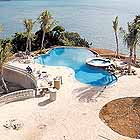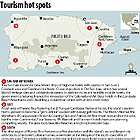|
 |
|
Esta página no está disponible en español. Orlando SentinelIsland Bets Big On TourismBy Iván Román
November 9, 2002
What down market? (LOIS PHILIP FOR THE ORLANDO SENTINEL) ---------- FAJARDO, Puerto Rico -- With dozens of hotels going up in Puerto Rico, Louis Phillipe is sure the 12th hole of the golf course wrapped around two hills will make Inter-Continental Cayo Largo Resort stand out. Golfers will tee off from high up, down a valleylike fairway carved through trees and small hills, just to hit the ball up again to an elevated green on the ocean, facing the Caribbean's largest deep-sea marina. Two holes over, golfers can take in the cloud-covered mountain top of El Yunque rainforest as they putt on the green. That's after they have already played the four holes on the front nine that wrap like a crescent around wetlands facing east, where the Atlantic Ocean meets the Caribbean Sea. Five outdoor whirlpool spas face that way too, with a view of the island towns of Vieques to the right, sea turtle-rich Culebra to the left, and on a clear day, St. Thomas just beyond. But now that he has built it, will they come? "I know they will," said Phillipe, general manager of the 313-room resort, which will open in January. "We've been marketing this hotel for over a year and the reception has been wonderful. You don't want to invest and buy in a booming market. It's a down cycle. Why not take advantage of it?"
Tourism hot spots. (THE ORLANDO SENTINEL) ---------- That may seem like twisted logic to those in the Caribbean still fretting about the drop in tourism since the terrorist attacks, but to others -- who are forking up the cash -- it makes sense. Investors, international hotel chains and the Puerto Rican government are pouring $2.2 billion into building resorts on the island or expanding hotels and inns -- by far the most aggressive development plan in the Caribbean, set to almost double the 12,000 hotel rooms on the island in about three years. Crews demolished buildings to make way for a new convention center in San Juan and workers soon will begin restoring two Colonial and Art Deco hotels in the city's Condado tourist strip. But new development is spread all over -- from large golf resorts in the east to smaller inns for eco-tourists on the island's long-neglected west coast. The JW Marriott, Four Seasons, Inter-Continental, Fairmont and Sol Meliá hotel chains all plan to help build and run golf resorts on Puerto Rico's lush northeastern and eastern coasts, joining the Westin Riomar, Wyndham El Conquistador and Palmas del Mar resorts already there to form a "golf corridor." Other hotels also are planned. In all, hotel rooms and condos would more than double in the compact area now known more for its greenery than its greens, and golfers would have a choice of 13 courses instead of the seven there now. "It's going to create a true golf destination that's going to help keep prices up like Cabos or Pebble Beach," said Efraim Kier, who plans to put 27 holes of golf at his 450-room Dos Mares resort, which will be run by JW Marriott when it is finished in two years. "The more international hotel chains come, the more people will come to Puerto Rico who didn't use to get down here." For government officials, that's what seals the deal. Puerto Rico's $2.5 billion tourism industry represents just 6 percent of the economy and business leaders see room for growth. Economist Joaquín Villamil said that for Puerto Rico, with only 12,000 hotel rooms, it makes sense to build more. "We have some catching up to do and here that's supply driven," said Villamil, president of the Puerto Rico Chamber of Commerce, who also runs his own economic analysis firm. "If you build more rooms, more people will come. And when the big chains build hotels, they bring their own market with them." Once almost exclusively dependent on leisure travelers from the United States content with lounging on a beach sipping piña coladas, Puerto Rico is trying to keep up with a tourism market that is becoming more sophisticated. Corporate travelers and small groups flock to the island, but officials hope the new convention center and 850-room hotel, along with more rooms around San Juan, will bring in large gatherings. Golf resorts, at $250 to $500 a night, shoot for high-end leisure tourists. Several moderately priced hotels and inns scattered across the island cater to those who want to ride horses, explore caverns, hike or spend time outdoors. Bucking the downturn In this tourist-dependent region of the world, Puerto Rico weathered the blow from the 2001 terrorist attacks better than most of its Caribbean neighbors by persuading local residents with a $1.6 million ad campaign to "Come, Get to Know Your Island." Hotels and inns also slashed rates, which helped hold hotel occupancy steady at about 73 percent this year. As tourists come back, hotel occupancy across the Caribbean has inched up -- hotel rates have not. Despite a $16 million "Life Needs the Caribbean" regional campaign that governments and hotel chains are splashing on TV screens in the mainland's frigid North, anticipated bookings for the winter season are soft, and less than pre-Sept. 11, 2001, highs. "The general feeling is that the recovery now will be into late 2003 to early 2004," said Alec Sanguinetti, deputy director general for the Caribbean Hotel Association. "It's just really the continuing economic and political conditions globally and in the U.S. The uncertainty of a war with Iraq drives down consumer confidence." Although the numbers make some in the region's $18.7 billion tourism industry a little skittish, they don't faze Milton Segarra, president of Puerto Rico's Tourism Co. He's banking on the island's mix of leisure, corporate, group, convention and local tourists to attract even more hotels and investors. The government is also pumping $500 million in low-interest or guaranteed loans into some of the 56 pending projects, which makes financing easier. "We are keeping up the pace of development in these times so when the good times hit hard, we have everything in place," Segarra said. "We are expecting this increase based on the projections of the economy. And people will see that growth and make a return on their investment." About 10,000 construction jobs will be created during the next three years, with thousands of hotel jobs added once doors are open for business. The World Travel and Tourism Council estimated that in 1999, 43,000 jobs were directly tied and another 78,000 were indirectly tied to the tourism and travel industry in Puerto Rico. Global competition and the disappearance of federal tax breaks have forced manufacturers to lay off thousands of Puerto Ricans since 2000. The government has been exploring ways to pick up the slack. Pumping money into tourism -- and thereby creating jobs -- fit the bill. "I think everyone in the market welcomes more rooms," said Erin Benítez, executive vice president of the Puerto Rico Hotel and Tourism Association. "It means more competition, and as everyone is promoting the island, the pie will grow. And the government is working toward that with us as a team." Environmental concerns Although many in the Caribbean are championing the wave of development, some environmentalists are concerned that the golf resorts that are in the 3,200-acre Northeast Ecological Corridor in Fajardo and Luquillo will damage the area's natural resources. Parts of the resorts -- to be run by JW Marriott and Four Seasons -- would be in the designated ecological corridor, a stretch of wetlands and beaches where egrets live and endangered sea turtles come to nest. Within a 13-mile trek in the area, people can travel from dry coastal forest to lush rainforest with ferns as wide and long as washing machines. Forty species of plants and animals are endemic to the area and it features two pristine phosphorescent bays that glow bright on moonless nights. Activists say the area's natural beauty should be used for an eco-resort where tourists and the public can go mountain biking or look at the sea turtles nesting under close supervision instead of building villas by the oceanfront sand dunes. "Why do they want to build three more golf courses in a zone that has natural and ecological value?" said Luis Jorge Rivera, with the Community Initiative for Sustainable Development. "We are not diversifying, but offering more of the same for a privileged sector of society and blocking the public from those lands." But the government is not just promoting the big resorts. It is offering loans to small inn owners and investors who want to build or expand medium-sized hotels facing the golden sunsets off the west coast or the coconut groves that line the beaches in the northwest.Tourism leaders point to the central and western hills, where a vast cave system, surfing, pristine canyons and coffee plantations are the main attractions for eco-tourists, a group they say will propel growth in the industry. "The west has more of a nature feel, a country feel," with diving off the island of Desecheo comparable to Hawaii, said Benítez of the hotel and tourism association. "There's beautiful sunsets, shady lanes. Most development is small and low rise, run by mom and pop, so they have a homey feel." That's what Michael Leason was going for, with a little more luxury, when he built the 36 oceanfront villas that make up Villa Montaña in the northwestern town of Isabela. But he was hedging his bets. At the condo hotel, people buy the fully furnished villas and offer them to tourists 11 months out of the year. Add a front desk and staff to run the place, offer a pool, tennis, a spa, massages and a stable of horses, and you've got a hotel. Developers like the idea so much that 35 percent of the new or planned hotel rooms in Puerto Rico -- 3,800 of more than 11,000 -- plan the same setup. "When I first opened here in 1996, there was nothing else here and people thought I was nuts," said Leason, 48, a Wisconsin native who came to Puerto Rico to head a filter-making company right after college. "This is a small place, unique, more down island." The answer to him is niche marketing. So much so that he sold Villa Montaña to another hotelier and right behind it he is building 16 more $500,000 villas on a cliff by the ocean. "This is small and isolated, but some people look for that," Leason said. "You can walk the beach here and not see anybody, and you don't have to go to St. Kitts to do it. . . . There are downsides, like crazy drivers. But in warmth and friendliness in the Caribbean, you can't beat it."
|

 ----------
---------- ----------
----------